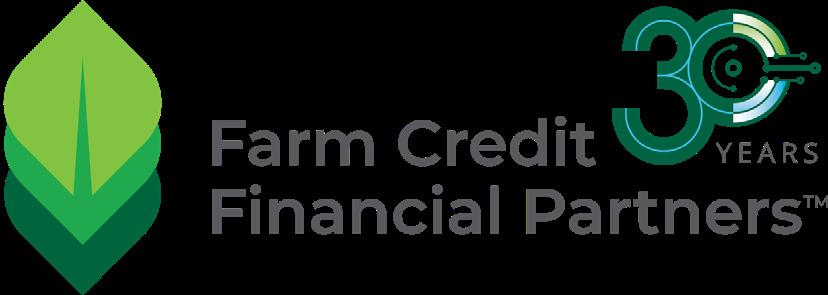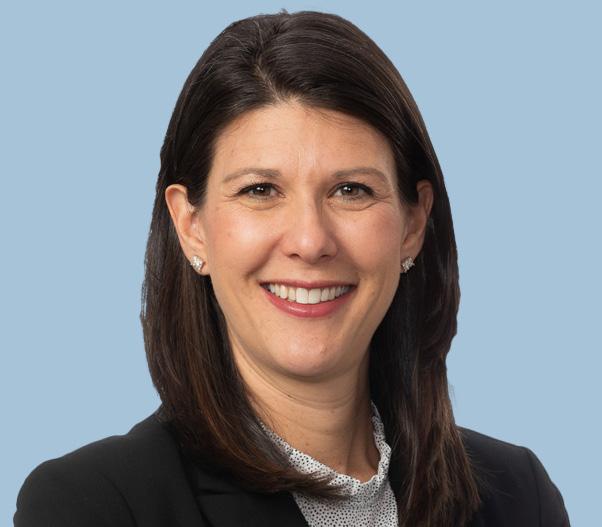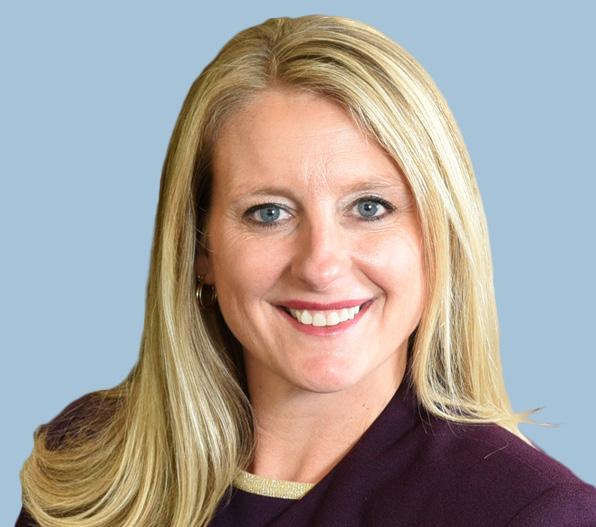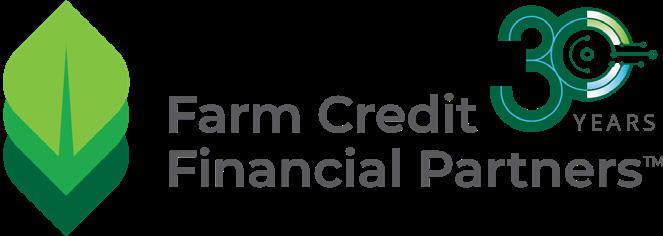




Delivering the trusted technology solutions our customers use to help American agriculture thrive.









Delivering the trusted technology solutions our customers use to help American agriculture thrive.



As Farm Credit Financial Partners Inc. (FPI) celebrates its 30th anniversary, we reflect with pride on three decades of delivering trusted technology products and services to the Farm Credit System. This significant milestone offers a moment to honor our legacy while embracing the opportunities that lie ahead.
2024 was a year marked by notable progress towards our vision and thoughtful preparation for the future. We advanced our multi-year strategy to build a modular, future-proof technology architecture tailored to meet the needs of our customers. Alignment with our owners on a greenfield approach has been crucial, allowing us to establish a modern system unburdened by legacy technology. As part of this effort, our customers will transition from the Salesforce Service Cloud platform to Financial Services Cloud, enabling them to fully leverage new features designed specifically for financial institutions.
Key initiatives in 2024 included modernizing our data environment to improve scalability and security, reducing dependencies on outdated systems to enhance efficiency, and adopting a more strategic approach to system integration to drive seamless interoperability. These foundational improvements have not only strengthened our capabilities but have also positioned us to take on more complex, high-impact projects in 2025.
We also improved our service management framework, bolstering structure, rigor, and performance measurement to better support our customers. These advancements have strengthened how we manage services, track key metrics, and drive accountability. While there is still work to do in fully maturing this space, this progress was a critical part of 2024. As a result, FPI can focus on delivering reliable, flexible solutions while enhancing collaboration with our customers as they strengthen their IT operations.
With our greenfield strategy, we are prioritizing adaptability and speed to market, reinforcing our commitment to solutions that address the ever-changing demands of an increasingly dynamic marketplace. Development of Financial Services Cloud will continue throughout 2025, with implementation planned for most customers in early 2026.
2025 will be a pivotal year, focused on modernization and effectiveness. Our key priorities include:

• Eliminating Legacy Dependencies: Retiring outdated platforms to enable streamlined, optimized operations.
• Out-of-the-Box Functionality : Delivering pre-configured solutions whenever possible to foster an ecosystem that promotes integration and rapid innovation.
• Investing in Long-Term Value: Though system changes may not be immediately visible, we are laying the foundation for future capabilities and long-term success, ensuring lasting value for our customers and their customer-members.
Guided by our strategic plan, we are committed to delivering solutions that not only address our customers’ challenges today but also position them for sustained success.

In keeping with our commitment to progress and adaptation, 2024 marked a significant transition period for our Board of Directors. In December, we bid farewell to Mark Littlefield, former President and CEO of AgWest Farm Credit, and Aaron Johnson, former President and CEO of Farm Credit Illinois (FCI), as they retired after years of distinguished leadership. Their vision, collaboration, and dedication were instrumental to FPI’s success, leaving a lasting legacy. We thank them for their remarkable contributions and wish them well in their next chapters.
We were pleased to welcome three new Board members: Bill Perry, President and CEO of AgWest; Kelly Hunt, President and CEO of FCI; and Denise Warkomski, Chief Operating Officer of AgWest. Their expertise and fresh perspectives will be invaluable as we execute our strategic vision and strengthen our governance model to align with long-term objectives.
Another significant governance change resulted from the collaboration formed in April 2024 between AgCountry Farm Credit Services, Farm Credit Services of America, and Frontier Farm Credit. This partnership led to adjustments in our Board composition, including offboarding two AgCountry executives. We remain committed to working closely with their leadership team to ensure a smooth transition off FPI systems. We also extend our gratitude to Marc Knisely and Jessica Fyre for their dedicated service on our Board.
As we navigate this period of transformation, our commitment to executing on our shared vision, delivering value to customers, and maintaining alignment with our Board remains unwavering. This milestone year is a testament to the strength of our partnerships and the dedication of our teams, whose collective efforts drive our success.
With a strong vision for 2025 and beyond, we are focused on delivering future-ready, adaptable solutions that empower our customers to thrive. At the same time, we recognize the significant workload ahead—with ambitious initiatives, complex interdependencies, and a fast-moving landscape demanding focus and agility. We are approaching this year with clear priorities, disciplined execution, and a proactive approach to risk management—ensuring we remain on track to meet our commitments. By strategically allocating resources and maintaining operational rigor, we are well-positioned to drive progress and deliver meaningful results this year.
Building on our legacy of partnership and innovation, we will continue driving shared success and reinforcing our role of serving as the trusted technology partner for the Farm Credit System—now and in the future.
BOB PASSINI President and Chief Executive Officer Farm Credit Financial Partners

MICHAEL J. REYNOLDS Chair of the Board Chief Executive Officer Farm Credit East


MICHAEL J. REYNOLDS Chair of the Board Chief Executive Officer Farm Credit East

TOM NAKANO Vice Chair of the Board Chief Financial Officer AgWest Farm Credit

JOHN BARCELOS Chief Risk Officer AgWest Farm Credit

BRIANA BEEBE
Executive Vice President and Chief Operating Officer Farm Credit East

KELLY HUNT
President and Chief Executive Officer Farm Credit Illinois

BILL PERRY
President and Chief Executive Officer AgWest Farm Credit

RYAN BERG Senior Vice President and Chief Operating Officer Farm Credit Illinois

WARKOMSKI Chief Operating Officer AgWest Farm Credit


BOB PASSINI
President and Chief Executive Officer

JESS BARNES Vice President People and Culture

STEVE DEMERITT
Executive Vice President IT Operations

JAMIE MANNING Chief of Staff and Corporate Secretary

JIM MCCORMACK
Executive Vice President Chief Technology Officer

SCOTT ROUSSEAU
Executive Vice President Chief Financial Officer and Treasurer

JASON WARREN Vice President Chief Information Security Officer

The following discussion summarizes the financial position and results of operations of Farm Credit Financial Partners, Inc. (FPI, we, our or the Company) as of and for the year ended December 31, 2024. Comparisons with prior years are included. The discussion and analysis should be read in conjunction with the accompanying financial statements, footnotes, and other sections of this report. The accompanying financial statements were prepared under the oversight of our Audit Committee. The Management’s Discussion and Analysis includes the following sections:
• Business Overview
• Year in Review
• Results of Operations
• Liquidity and Funding Sources
• Ownership and Capital
• Governance
• Forward-Looking Information
FPI operates as part of the Farm Credit System (the System or Farm Credit), which was created by Congress in 1916 and has served agricultural producers for over 100 years. The System’s mission is to provide sound and dependable credit to American farmers, ranchers, and other agricultural producers and farm-related businesses through a member-owned cooperative system. FPI serves System association lenders in providing comprehensive technology systems and services. The Farm Credit Administration (FCA) is the System’s independent safety and soundness federal regulator and was established to supervise, examine, and regulate System institutions
For over 30 years, FPI has supported the Farm Credit mission and agricultural credit associations (ACAs) through technology delivery. FPI’s investments in its technology and services portfolio have yielded a suite of technology solutions and services tailored for Farm Credit. Our vision is to equip its customers-owners with tools that enable them to succeed in
a competitive landscape.
Consistent with other Farm Credit institutions, FPI is organized as a cooperative, with ownership comprised 100% of Farm Credit ACAs. This cooperative model facilitates alignment between customer needs and owner governance and direction
As FPI marks its 30th anniversary, we honor our legacy of delivering trusted technology products and services to the Farm Credit System while positioning ourselves for future opportunities and continued success.
In 2024, we made significant strides in advancing our strategic vision and laying the foundation for future growth and innovation. We advanced our multi-year strategy to build a modular, future-proof technology architecture, aligning with our owners on a greenfield approach to establish a modern system unburdened by legacy technology. The greenfield strategy prioritizes adaptability and speed to market, reinforcing our commitment to solutions that address evolving marketplace demands. A key initiative in this effort is transitioning from



Salesforce Service Cloud to Financial Services Cloud, allowing customers to leverage features designed for financial institutions. Development of Financial Services Cloud will continue in 2025, with implementation planned for early 2026.
Additional initiatives focused on modernizing our data environment for scalability and security, reducing reliance on outdated systems, and improving system integration for seamless interoperability. These improvements strengthen our capabilities and position us for complex, high-impact projects in 2025.
We also enhanced our service management framework, adding structure, rigor, and performance measurement to better support customers. While work remains, these advancements improve service management, tracking key metrics, and accountability. The coming year will be pivotal, focused on modernization and effectiveness. Key priorities include eliminating legacy dependencies for optimized operations, leveraging outof-the-box system functionality to foster integration and rapid innovation, and investing in long-term value to
build future capabilities. We remain committed to delivering solutions that address today’s challenges while ensuring sustained success.
Guided by our strategic vision, we are dedicated to delivering exceptional value to our customers while ensuring strong alignment with our Board. Looking ahead to 2025, we continue to develop adaptable, future-ready solutions while proactively managing risks and responding to an evolving landscape with discipline and agility. By prioritizing strategic resource allocation and operational excellence, we are wellpositioned to drive meaningful progress and sustainable results and meet evolving business and customer needs.
In 2024, FPI successfully met its financial objectives, achieving a net income that was slightly favorable to its breakeven target. Our strong operational and financial performance was driven by the strategic management of operating expenses, capital investments, and project expenditures. Cash reserves at year-end exceeded expectations, and liquidity remains sufficient to support future initiatives, including new product
implementations and the modernization of legacy systems. Throughout the year, FPI maintained its commitment to delivering high-quality customer service and production support, ensuring continued customer satisfaction.
Total revenue for 2024 amounted to $82,390k, reflecting an increase of $6,325k, or 8.3%, compared to the previous year. This growth was primarily driven by a $2,886k, or 4.8% increase in standard services revenue, along with an increase of $2,982k, or 70.1% in custom services revenue related to project work. Additionally, passthrough and other revenues contributed an additional $510K in growth over 2023 levels.
Operating expenses totaled $82,571k in 2024 as compared to $76,696k in 2024 for an increase of $5,875k, or 7.7%. Similar to revenue, operating expense increases were driven by costs incurred to deliver both standard and custom services.
From a financial statement line-item perspective, salary and employee

benefit expenses increased by $2,912k over 2023, primarily due to a 3.0% increase in average year over year headcount to support the additional demand for standard and custom services. Purchased services costs increased by $3,196k as compared to 2023. The drivers of this increase are continued investments in FPI’s technology platform, custom projects and cloud services costs related to increased product adoption of our production systems. Occupancy and equipment costs and other expenses decreased by a combined $233k as compared to prior year levels primarily due to lower maintenance costs and depreciation of on-premises infrastructure.
FPI is reporting other income of $337k for the year. This is driven by Interest income and the Company’s reflection of ASU 2017-07 and the reporting of other components of net periodic pension cost in this section of the statement. While service costs, which are reported in the salaries and employee benefits line of the statement of operations, represent the value of expected pension benefits to be earned during the year, the other components of net periodic pension cost include the annual interest cost on the projected benefit obligation less the expected return on plan assets plus the amortization of any prior service
costs and actuarial gains and losses. Additional details are available in footnote 13 – Employee Benefit Plans.
Our income tax provision for the year of $24k is due to a combination of our 2024 tax provision and the difference between our prior year provision and actual taxes filed.
The 2024 net income is $132k as compared to a prior year net income of $91k.
FPI operates with the following primary sources of funding:
1. Revenue for standard and enhanced services.
2. Revenue from custom and other projects.
3. Capital funding from owners.
In addition, FPI maintains a $3.75 million line of credit with CoBank. This line renews annually on July 31.
Funding levels are established and approved annually during the budget planning cycle. Capital funding is planned over a three-year cycle and reviewed annually.
The capital plan identifies key strategic projects and related funding sources. Completion of these projects is positioning FPI to effectively meet technology demands and create business value for our owners.
As of December 31, 2024, FPI had three customer-owners with stock investments totaling $27.8 million.
During the year, AgCountry Farm Credit Services exited ownership of FPI. To ensure the continuity of capital investment, FPI’s remaining owners reinvested capital, maintaining total stock ownership levels across the cooperative. As part of this recapitalization, stock investments were equalized across common and preferred stock share classes among the three remaining shareholders.
Total equity on December 31, 2024 equaled $27,017k, an increase of $1,043k over 2023. Changes in the equity section of the balance sheet include a decrease in the accumulated other comprehensive loss line item of $910k and current year net income of $132k. The accumulated other comprehensive loss decrease is due to a reduction in FPI’s defined benefit pension plan liability during the year.
FPI’s Board approved capital plan provides for continued investment in FPI’s strategic initiatives and ongoing investments in operations, controls, and information security over the 2025-2027 periods.
FPI’s Board of Directors is comprised of senior executives of each customerowner, including the CEO. FPI’s Board operates under a committee structure. The committees include:
The Audit Committee is composed
of Board members representing each owner with one Committee member elected as the Chair and one elected as Vice Chair. The Audit Committee responsibilities include, but are not limited to:
• Oversight of the financial reporting risk and the accuracy of the annual shareholder reports.
• Oversight of the internal controls related to the preparation of annual shareholder reports.
• Review and assessment of the impact of accounting and auditing developments on the consolidated financial statements.
• Establishment and maintenance of procedures for the receipt, retention, and treatment of confidential and anonymous submission of concerns, regarding accounting, internal accounting controls or auditing matters.
• Oversight of the Company’s internal audit program, the independence of the outside auditors, the adequacy of the Company’s system of internal controls and procedures, and the adequacy of management’s action with respect to recommendations arising from those auditing activities.
The Human Capital Committee is responsible for the oversight of employee compensation. The Human Capital Committee is composed of one Board member from each owner ACA with one Committee member elected as the Chair and one elected as Vice Chair. The Committee reviews, evaluates and approves the compensation policies, programs and plans for senior officers and employees including benefits programs.

Our discussion contains forward-looking statements. These statements are not guarantees of future performance and involve certain risks, uncertainties and assumptions that are difficult to predict. Words such as “anticipates,” “believes,” “could,” “estimates,” “may,” “should,” and “will,” or other variations of these terms are intended to identify forwardlooking statements. These statements are based on assumptions and analyses made in light of experience and other historical trends, current conditions, and expected future developments. However, actual results and developments may differ materially from our expectations and predictions due to a number of risks and uncertainties, many of which are beyond our control. These risks and uncertainties include, but are not limited to fluctuations in the economy, the relative strengths and weaknesses in the agricultural credit sectors and in the real estate market, and the actions taken by the Federal Reserve in implementing monetary policy.



The financial statements of Farm Credit Financial Partners, Inc. (the Company) are prepared by management, who is responsible for their integrity and objectivity, including amounts that must necessarily be based on judgments and estimates. The financial statements have been prepared in conformity with accounting principles generally accepted in the United States of America. The financial statements, in our opinion, fairly present the financial condition of the Company. Other financial information included in this 2024 annual report is consistent with that in the financial statements.
To meet our responsibility for reliable financial information, management depends on accounting and internal control systems designed to provide reasonable, but not absolute assurance that assets are safeguarded and transactions are properly authorized and recorded. Costs must be reasonable in relation to the benefits derived when designing accounting and internal control systems. To monitor compliance, the Company’s internal auditors perform audits of accounting records, review accounting systems and internal controls, and recommend improvements as appropriate. The financial statements are audited by RSM US LLP, our independent auditors, in accordance with auditing standards generally accepted in the United States of America. The Company is also examined by the Farm Credit Administration.
The chief executive officer, as delegated by the Board of Directors, has overall responsibility for the Company’s system of internal controls and financial reporting, subject to the review of the Audit Committee of the Board of Directors. The Audit Committee consults regularly with management and meets periodically with the independent auditors and internal auditors to review the scope and results of their examinations. The Audit Committee reports regularly to the Board of Directors. Both the independent auditors and the internal auditors have direct access to the Audit Committee.
The undersigned certify that the 2024 Annual Report to Shareholders and information contained herein is true, accurate and complete to the best of our knowledge and belief.
BOB PASSINI
President and Chief Executive Officer
Farm Credit Financial Partners
March 4, 2025
SCOTT ROUSSEAU
Chief Financial Officer
Farm Credit Financial Partners
March 4, 2025
MICHAEL J. REYNOLDS Chair of the Board
Chief Executive Officer
Farm Credit East
March 4, 2025

The consolidated financial statements were prepared under the oversight of the Audit Committee (Committee). The Committee is composed of a subset of the Board of Directors of Farm Credit Financial Partners, Inc. (FPI). The Committee oversees the scope of FPI’s internal audit program, the approval and independence of RSM US LLP (RSM) as external auditors, the adequacy of FPI’s system of internal controls and procedures, and the adequacy of management’s action with respect to recommendations arising from those auditing activities. The Committee’s responsibilities are described more fully in the FPI’s Internal Controls Policy and the Audit Committee Charter.
Management is responsible for FPI’s internal controls and the preparation of the consolidated financial statements in accordance with accounting principles generally accepted in the United States of America. RSM is responsible for performing an independent audit of FPI’s consolidated financial statements in accordance with generally accepted auditing standards in the United States of America and to issue a report thereon. The Committee’s responsibilities include monitoring and overseeing these processes.
In this context, the Committee reviewed and discussed the audited consolidated financial statements for the year ended December 31, 2024, with management. The Committee also receives from RSM the matters required to be discussed by Statements on Auditing Standards.
The Committee approves all non-audit services provided by RSM, if any. In 2024, RSM was not engaged for non-audit services.
Based on the foregoing review and discussions, and relying thereon, the Committee recommended that the Board of Directors include the audited consolidated financial statements in the Annual Report for the year ended December 31, 2024 and for filing with the FCA.
TOM NAKANO
Chairperson of the Audit Committee
AgWest Farm Credit
March 4, 2025
Members of the Audit Committee:
John Barcelos
Kelly Hunt
Michael J. Reynolds
March 4, 2025


Farm Credit Financial Partners, Inc.
Farm Credit Financial Partners, Inc.
Opinion
Farm Credit Financial Partners, Inc.
Independent Auditor’s Report
We have audited the financial statements of Farm Credit Financial Partners, Inc. (the Company), which comprise the balance sheets as of December 31, 2024, 2023 and 2022, the related statement of operations, comprehensive income (loss), changes in equity accumulated other comprehensive loss and cash flows for the years then ended, and the related notes to the financial statements. In our opinion, the accompanying financial statements present fairly, in all material respects, the financial position of the Company as of December 31, 2024, 2023 and 2022, and the results of its operations and its cash flows for the years then ended in accordance with accounting principles generally accepted in the United States of America.
We have audited the financial statements of Farm Credit Financial Partners, Inc. (the Company), which comprise the balance sheets as of December 31, 2024, 2023 and 2022, the related statement of operations, comprehensive income (loss), changes in equity accumulated other comprehensive loss and cash flows for the years then ended, and the related notes to the financial statements.
We have audited the financial statements of Farm Credit Financial Partners, Inc. (the Company), which comprise the balance sheets as of December 31, 2024, 2023 and 2022, the related statement of operations, comprehensive income (loss), changes in equity accumulated other comprehensive loss and cash flows for the years then ended, and the related notes to the financial statements.
In our opinion, the accompanying financial statements present fairly, in all material respects, the financial position of the Company as of December 31, 2024, 2023 and 2022, and the results of its operations and its cash flows for the years then ended in accordance with accounting principles generally accepted in the United States of America.
Basis for Opinion
In our opinion, the accompanying financial statements present fairly, in all material respects, the financial position of the Company as of December 31, 2024, 2023 and 2022, and the results of its operations and its cash flows for the years then ended in accordance with accounting principles generally accepted in the United States of America.
We conducted our audits in accordance with auditing standards generally accepted in the United States of America (GAAS). Our responsibilities under those standards are further described in the Auditor’s Responsibilities for the Audit of the Financial Statements section of our report. We are required to be independent of the Company and to meet our other ethical responsibilities, in accordance with the relevant ethical requirements relating to our audits. We believe that the audit evidence we have obtained is sufficient and appropriate to provide a basis for our audit opinion.
We conducted our audits in accordance with auditing standards generally accepted in the United States of America (GAAS). Our responsibilities under those standards are further described in the Auditor’s Responsibilities for the Audit of the Financial Statements section of our report. We are required to be independent of the Company and to meet our other ethical responsibilities, in accordance with the relevant ethical requirements relating to our audits. We believe that the audit evidence we have obtained is sufficient and appropriate to provide a basis for our audit opinion.
Responsibilities of Management for the Financial Statements
Responsibilities of Management for the Financial Statements
We conducted our audits in accordance with auditing standards generally accepted in the United States of America (GAAS). Our responsibilities under those standards are further described in the Auditor’s Responsibilities for the Audit of the Financial Statements section of our report. We are required to be independent of the Company and to meet our other ethical responsibilities, in accordance with the relevant ethical requirements relating to our audits. We believe that the audit evidence we have obtained is sufficient and appropriate to provide a basis for our audit opinion.
Responsibilities of Management for the Financial Statements
Management is responsible for the preparation and fair presentation of the financial statements in accordance with accounting principles generally accepted in the United States of America, and for the design, implementation, and maintenance of internal control relevant to the preparation and fair presentation of financial statements that are free from material misstatement, whether due to fraud or error.
Management is responsible for the preparation and fair presentation of the financial statements in accordance with accounting principles generally accepted in the United States of America, and for the design, implementation, and maintenance of internal control relevant to the preparation and fair presentation of financial statements that are free from material misstatement, whether due to fraud or error.
Management is responsible for the preparation and fair presentation of the financial statements in accordance with accounting principles generally accepted in the United States of America, and for the design, implementation, and maintenance of internal control relevant to the preparation and fair presentation of financial statements that are free from material misstatement, whether due to fraud or error.
In preparing the financial statements, management is required to evaluate whether there are conditions or events, considered in the aggregate, that raise su bstantial doubt about the Company’s ability to continue as a going concern within one year after the date that the financial statements are issued or available to be issued.
In preparing the financial statements, management is required to evaluate whether there are conditions or events, considered in the aggregate, that raise substantial doubt about the Company’s ability to continue as a going concern within one year after the date that the financial statements are issued or available to be issued.
Auditor’s Responsibilities for the Audit of the Financial Statements
In preparing the financial statements, management is required to evaluate whether there are conditions or events, considered in the aggregate, that raise substantial doubt about the Company’s ability to continue as a going concern within one year after the date that the financial statements are issued or available to be issued.
Auditor’s Responsibilities for the Audit of the Financial Statements
Our objectives are to obtain reasonable assurance about whether the financial statements as a whole are free from material misstatement, whether due to fraud or error, and to issue an auditor’s report that includes our opinion. Reasonable assurance is a high level of assurance but is not absolute assurance and therefore is not a guarantee that an audit conducted in accordance with GAAS will always detect a material misstatement when it exists. The risk of not detecting a material misstatement resulting from fraud is higher than for one resulting from error, as fraud may involve collusion, forgery, intentional omissions, misrepresentations, or the override of internal control. Misstatements are considered material
Our objectives are to obtain reasonable assurance about whether the financial statements as a whole are free from material misstatement, whether due to fraud or error, and to issue an auditor’s report that includes our opinion. Reasonable assurance is a high level of assurance but is not absolute assurance and therefore is not a guarantee that an audit conducted in accordance with GAAS will always detect a material misstatement when it exists. The risk of not detecting a material misstatement resulting from fraud is higher than for one resulting from error, as fraud may involve collusion, forgery, intentional omissions, misrepresentations, or the override of internal control. Misstatements are considered material if there is a substantial likelihood that, individually or in the aggregate, they would influence the judgment made by a reasonable user based on the financial statements.
Our objectives are to obtain reasonable assurance about whether the financial statements as a whole are free from material misstatement, whether due to fraud or error, and to issue an auditor’s report that includes our opinion. Reasonable assurance is a high level of assurance but is not absolute assurance and therefore is not a guarantee that an audit conducted in accordance with GAAS will always detect a material misstatement when it exists. The risk of not detecting a material misstatement resulting from fraud is higher than for one resulting from error, as fraud may involve collusion, forgery, intentional omissions, misrepresentations, or the override of internal control. Misstatements are considered material if there is a substantial likelihood that, individually or in the aggregate, they would influence the judgment made by a reasonable user based on the financial statements.


In performing an audit in accordance with GAAS, we:
In performing an audit in accordance with GAAS, we:
Exercise professional judgment and maintain professional skepticism throughout the audit.
• Exercise professional judgment and maintain professional skepticism throughout the audit.
Identify and assess the risks of material misstatement of the financial statements, whether due to fraud or error, and design and perform audit procedures responsive to those risks. Such procedures include examining, on a test basis, evidence regarding the amounts and disclosures in the financial statements.
• Identify and assess the risks of material misstatement of the financial statements, whether due to fraud or error, and design and perform audit procedures responsive to those risks. Such procedures include examining, on a test basis, evidence regarding the amounts and disclosures in the financial statements.
Obtain an understanding of internal control relevant to the audit in order to design audit procedures that are appropriate in the circumstances, but not for the purpose of expressing an opinion on the effectiveness of the Company’s internal control. Accordingly, no such opinion is expressed.
• Obtain an understanding of internal control relevant to the audit in order to design audit procedures that are appropriate in the circumstances, but not for the purpose of expressing an opinion on the effectiveness of the Company’s internal control. Accordingly, no such opinion is expressed.
• Evaluate the appropriateness of accounting policies used and the reasonableness of significant accounting estimates made by management, as well as evaluate the overall presentation of the financial statements.
Evaluate the appropriateness of accounting policies used and the reasonableness of significant accounting estimates made by management, as well as evaluate the overall presentation of the financial statements.
• Conclude whether, in our judgment, there are conditions or events, considered in the aggregate, that raise substantial doubt about the Company’s ability to continue as a going concern for a reasonable period of time.
Conclude whether, in our judgment, there are conditions or events, considered in the aggregate, that raise substantial doubt about the Company’s ability to continue as a going concern for a reasonable period of time.
We are required to communicate with those charged with governance regarding, among other matters, the planned scope and timing of the audit, significant audit findings, and cer tain internal control-related matters that we identified during the audit.
We are required to communicate with those charged with governance regarding, among other matters, the planned scope and timing of the audit, significant audit findings, and certain internal control-related matters that we identified during the audit.

Boston, Massachusetts March 4, 2025
AS OF DECEMBER 31, 2024, 2023, AND 2022
Liabilities
Long-term liabilities:
Commitments and contingencies (Note 16)
Equity
Class A preferred stock, $5.00 par value, 5,000,000 shares authorized, 3,220,200 shares issued and outstanding as of December 31, 2024; 2,500,000 shares issued and outstanding as of December 31, 2023 and 2022.
Class B preferred stock, $5.00 par value, 5,000,000 shares authorized, 2,340,000 shares issued and outstanding as of December 31, 2024; 1,950,000 shares issued and outstanding as of December 31, 2023 and 2022.
Class C common stock, $5.00 par value, 5,000,000 shares authorized, 0 shares issued and outstanding as of December 31, 2024; 1,110,000 shares issued and outstanding as of December 31, 2023 and 2022.
YEARS ENDED DECEMBER 31, 2024, 2023, AND 2022
YEARS ENDED DECEMBER 31, 2024, 2023, AND 2022
of Cash Flows
YEARS ENDED DECEMBER 31, 2024, 2023, AND 2022
Cash Flows from Operating Activities
Adjustments to reconcile net income to net cash
Cash Flows from Investing Activities
Cash Flows from Financing Activities
YEARS ENDED DECEMBER 31, 2024, 2023, AND 2022
YEARS ENDED DECEMBER 31, 2024, 2023, AND 2022
Balance as of January 1, 2022
as of December 31, 2022
Balance as of December 31, 2023 (3,040,323) (295,951) (3,336,274)
Balance as of December 31, 2024 (2,104,662) $

Farm Credit Financial Partners, Inc. (FPI or the Company) is engaged principally in providing information technology, financial services support, and other services to associations in the Farm Credit System (the System). Currently, FPI services associations funded through CoBank, ACB (CoBank), an agricultural credit bank in the Farm Credit System, as well as association customers of AgriBank, FCB a farm credit bank in the Farm Credit System.
The Farm Credit Administration (FCA) chartered FPI as a service corporation under Section 4.25 of the Farm Credit Act of 1971, as amended (the Act). The FCA has authority under the Act to charter and regulate Farm Credit System banks, associations and service corporations. The activities of FPI are examined by FCA and certain actions by FPI are subject to the prior approval of FCA and FPI owner associations.
The Company is headquartered in Springfield, Massachusetts.
A. Basis of Presentation
The accompanying financial statements have been prepared in accordance with accounting standards set by the Financial Accounting Standards Board (FASB). The FASB sets generally accepted accounting principles (GAAP) in the United States that the Company follows to ensure its financial condition, results of operations and cash flows are consistently reported. References to GAAP issued by the FASB in these notes to the financial statements are to the FASB Accounting Standards Codification (ASC).
B. Use of Estimates
The preparation of financial statements in conformity with GAAP requires management to make estimates and assumptions that affect the amounts reported in the financial statements and accompanying notes. Significant estimates include the valuation of deferred tax assets and liabilities, assets and liabilities associated with employee benefit plans, revenue recognition, and software development costs, and are discussed in these footnotes, as applicable. Actual results may differ from those estimates.
C. Cash and Cash Equivalents
Cash includes cash on hand and on deposit at banks. Cash equivalents are FPI’s investments in a short-term money market fund with an original maturity of three months or less. The money market fund invests in U.S. dollar-denominated short-term debt obligations including securities issued by the U.S. Government or its agencies, bankers’ acceptances, certificates of deposit, time deposits from U.S. or foreign banks, repurchase agreements, commercial paper, municipal securities and master notes.
Accounts receivable are stated at the amount management expects to collect from outstanding balances. Effective January 1, 2023, the Company adopted Accounting Standards Update (ASU) 2016-13, Financial Instruments – Credit Losses (Topic 326): Measurement of Credit Losses on Financial Instruments (ASU 2016-13) prospectively. This ASU replaces the incurred loss impairment model with an expected credit loss impairment model for financial instruments, including trade receivables. The guidance requires entities to consider forward-looking information to estimate expected credit losses, resulting in earlier recognition of losses for receivables that are current or not yet due, which were not considered under the previous accounting guidance. The Company performed an assessment of its allowance for credit losses and determined that no adjustment was required to accumulated earnings upon adoption.
The Company estimates the allowance for credit losses through an assessment of historical bad debt write-off experience, current economic and market conditions, management’s evaluation of outstanding accounts receivable and anticipated recoveries. Due to the short-term nature of receivables, the estimate of credit losses is primarily based on aged accounts receivable balances and the financial condition of the Company’s customers. In addition, specific allowance amounts are established to record the appropriate provision for customers that have a higher probability of default. Bad debts are written off against the allowance when identified. The allowance for credit losses balance at December 31, 2024, 2023, and 2022 was $0. Bad debt expense was $0 for the years ended December 31, 2024, 2023, and 2022.
At times, FPI performs services for customers in advance of invoicing for such services. These amounts are recorded as unbilled revenue, are included in prepaid and other assets in the accompanying balance sheets, and amount to $1,404,593, $1,826,784 and $829,906, at December 31, 2024, 2023, and 2022, respectively.
Fixed assets are carried at cost less accumulated depreciation. Depreciation is computed using the straight-line method over the estimated useful lives of five to ten years for furniture and fixtures, and three to seven years for computer equipment and software. Gains and losses on dispositions are reflected in other operating expenses on the statements of operations. Maintenance and repairs are charged to operating expense and improvements are capitalized.
The Company is developing new products which the Company intends to offer as part of its core services and is developing significant upgrades and enhancements to its existing software as-a-service (SaaS) platform. The Company follows the guidance of ASC 350-40, Intangibles – Goodwill and Other – Internal-Use Software, for development costs related to these new products. Costs incurred in the planning stage are expensed as incurred while costs incurred in the application development stage are capitalized, assuming such costs are deemed to be recoverable. Costs incurred in the operating stage are generally expensed as incurred except for significant upgrades and enhancements. Software development costs are amortized over the software’s estimated useful life, which management has determined to be three to seven years. Software development costs are included in intangible assets, net in the accompanying balance sheets and disclosed in more detail in Note 5.
The funded status of pension and other post-retirement benefit plans is recognized in the balance sheets in long-term accrued employee benefits. Gains and losses, prior service costs and credits that have not yet been recognized through pension expense will be recognized in accumulated other comprehensive loss, net of tax, until they are amortized as a component of net periodic pension/post-retirement benefits expense.
Pension expense is based on an actuarial computation of future benefits using estimates for expected return on assets, expected compensation increases and applicable discount rates. Expected compensation increases are estimated based on historical and expected increases in the future. Increases in estimated compensation would result in higher pension expense while decreases would lower pension expense. Discount rates are selected based upon rates of return on fixed income investments currently available and expected to be available during the period to maturity of the pension benefit. Detailed rate assumptions are included in Note 13.
Effective January 1, 2005, the Company closed the existing defined benefit retirement plan to new participants. All employees hired on or after January 1, 2005 are participants in a noncontributory defined contribution plan. Participants in this plan receive a fixed percentage of their eligible wages in an investment account maintained for the employee. Costs for these benefits are recorded in the period in which they are incurred in salaries and employee benefits on the statements of operations.
Company employees are also eligible to participate in an employee savings plan. The Company matches a certain percentage of employee contributions with costs being expensed as funded. Costs for these benefits are recorded in the period in which they are incurred in salaries and employee benefits on the statements of operations.
The Company also provides certain health care and life insurance benefits to employees. Costs for these benefits are recorded in the period in which they are incurred in salaries and employee benefits on the statements of operations.
The Company is organized as a C Corporation for Federal Income Tax purposes and files a Form 1120-C. The Company uses the asset and liability method of accounting for income taxes whereby deferred tax assets and liabilities are recognized for the estimated future tax consequences attributable to differences between the financial statement carrying amounts of existing assets and liabilities and their respective tax bases. The effect on deferred tax assets and liabilities of a change in tax rates is recognized in income in the period that includes the enactment date. The Company also reduces deferred tax assets by a valuation allowance if, based on the weight of available evidence, it is more likely than not that some portion or all of the recorded deferred tax assets will not be realized in future periods. This methodology requires estimates and judgments in the determination of the recoverability of deferred tax assets and in the calculation of certain tax liabilities. Valuation allowances are recorded against the gross deferred tax assets that management believes, after considering all available positive and negative objective evidence, historical and prospective, with greater weight given to historical evidence, that it is more likely than not that these assets will not be realized.
In addition, the Company is required to recognize in the financial statements, those tax positions determined to be more likely than not of being sustained upon examination, based on the technical merits of the positions as of the reporting date. If a tax position is not considered more likely than not to be sustained based solely on its technical merits, no benefits of the position are recognized. The Company recognizes interest and penalties as a component of the provision for income taxes in the accompanying statements of operations. The Company does
not believe it has any material uncertain tax positions.
Interest and penalties paid were $982, $4,468, and $18,843 for the years ending December 31, 2024, 2023, and 2022. The Company is no longer subject to federal, state, and local income tax examinations by tax authorities for years prior to 2020.
The Company derives revenue from core and custom services from its customers, all of which are lending associations in the Farm Credit System. Standard and custom services include credit delivery and management systems, core infrastructure and security, financial accounting and loan accounting services, management reporting, electronic commerce, legal support, and custom solutions, which include a retained technology services team dedicated to any specific projects required by the customer over a period of time which is typically one year.
The Company recognizes revenue in accordance with ASC 606, Revenue from Contracts with Customers, which provides a five-step model for recognizing revenue from contracts with customers as follows:
• Identify the contract with a customer
• Identify the performance obligation(s) in the contract
• Determine the transaction price
• Allocate the transaction price to the performance obligation(s) in the contract
• Recognize revenue when or as performance obligation(s) are satisfied
The Company assesses the contract term as the period in which the parties to the contract have presently enforceable rights and obligations. Contracts are generally standardized and non-cancellable for the duration of the stated contract term. FPI has determined that its core services represent a series of promises which represent a single performance obligation. When FPI sells custom services, such services are generally negotiated separately from the core services. As a result, the Company has determined that it does not have contracts with multiple performance obligations. Such services are recognized over the period of performance under the input method. All revenues for the years ended December 31, 2024, 2023, and 2022 as reported within the statements of operations, are recognized over time.
The transaction price is the amount of consideration to which the Company expects to be entitled in exchange for transferring goods and services to the customer. Revenue from sales is recorded based on the transaction price, which includes estimates of variable consideration. The amount of variable consideration included in the transaction price is constrained to the extent it is probable that a significant reversal of cumulative revenue recognized will not occur when the uncertainty associated with the variable consideration is subsequently resolved. At the inception of a contract, the Company expects the period between when it satisfies its performance obligations, and when the customer pays for the services, will be one year or less. As such, the Company has elected to apply the practical expedient which allows the Company to not adjust the promised amount of consideration for the effects of a significant financing component when a financing component is present.
Payment terms on invoiced amounts are typically 30 days. The Company does not offer rights of return for its services in the normal course of business, and contracts generally do not include customer acceptance clauses. The Company also excludes from revenue governmentassessed and imposed taxes on revenue-generating activities that are invoiced to customers.
The timing of revenue recognition may not align with the right to invoice the customer. The Company records accounts receivable when it has the unconditional right to issue an invoice and receive payment regardless of whether revenue has been recognized. If revenue has not yet been recognized, a contract liability (deferred revenue) is recorded. If revenue is recognized in advance of the right to invoice, unbilled revenue is recorded.
Balances as of December 31, were as follows:
Costs to obtain and fulfill a contract: In accordance with ASC 340-40, Other Assets and Deferred Costs (ASC 340-40), the Company has elected to apply the practical expedient and recognize the incremental costs of obtaining contracts as an expense when incurred if the amortization period for the assets that the Company otherwise would have recognized is one year or less. Therefore, the Company would capitalize the incremental costs of obtaining a contract with a customer if the Company expects the benefit of those costs to be longer than one year and amortize such costs over the expected benefit period.
The Company considered the relevant guidance under ASC 340-40 and did not identify any incremental costs of obtaining a contract which would require capitalization for the years ended December 31, 2024, 2023, and 2022. The Company does not pay commissions in connection
with its contracts which would require capitalization under the provisions of ASC 340-40. Further, the Company did not identify other material contract acquisition and fulfillment costs where ASC 340-40 results in capitalization.
The Company adopted Topic 842 on January 1, 2022, using the modified retrospective approach, which eliminates the requirement to restate the prior-period financial statements. Under this transition provision, the Company has applied Topic 842 to reporting periods beginning on January 1, 2022, while prior periods continue to be reported and disclosed in accordance with the Company’s historical accounting treatment under ASC Topic 840, Leases.
The Company elected the “package of practical expedients” under the transition guidance within Topic 842, in which the Company does not reassess (1) the historical lease classification, (2) whether any existing contracts at transition are or contain leases, or (3) the initial direct costs for any existing leases. The Company has not elected to adopt the “hindsight” practical expedient, and therefore will measure the ROU asset and lease liability using the remaining portion of the lease term upon adoption of Topic 842 on January 1, 2022.
The Company determines if an arrangement is or contains a lease at inception, which is the date on which the terms of the contract are agreed to, and the agreement creates enforceable rights and obligations. A contract is or contains a lease when (i) explicitly or implicitly identified assets have been deployed in the contract and (ii) the Company obtains substantially all of the economic benefits from the use of that underlying asset and directs how and for what purpose the asset is used during the term of the contract. The Company also considers whether its service arrangements include the right to control the use of an asset.
The Company made an accounting policy election available under Topic 842 not to recognize ROU assets and lease liabilities for leases with a term of 12 months or less. The Company has one lease with a lease term of 12 months or less. For all other leases, ROU assets and lease liabilities are measured based on the present value of future lease payments over the lease term at the commencement date of the lease (or January 1, 2022, for existing leases upon the adoption of Topic 842). The ROU assets also include any initial direct costs incurred and lease payments made at or before the commencement date and are reduced by any lease incentives. To determine the present value of lease payments, the Company made an accounting policy election available to non-public companies to utilize a risk-free borrowing rate, which is aligned with the lease term at the lease commencement date (or remaining term for leases existing upon the adoption of Topic 842).
Adoption of Topic 842 resulted in the recording of additional ROU assets and lease liabilities related to the Company’s operating leases of $10,027,617 at January 1, 2022. The adoption of the new lease standard did not materially impact consolidated net earnings or consolidated cash flows and did not result in a cumulative-effect adjustment to the opening balance of retained earnings. See Note 15 for further information regarding the Company’s leases.
L. Concentrations of Credit Risk
Financial instruments which potentially subject the Company to credit risk consist primarily of cash, cash equivalents, accounts receivable and unbilled revenue. The Company maintains its cash and cash equivalents with high credit quality financial institutions, and monitors credit risk with individual financial institutions and issuers. At December 31, 2024, 2023, and 2022, the Company had cash balances at certain financial institutions in excess of federally insured limits; however, it has not experienced any losses in such accounts. See Note 17 for concentrations of revenue and accounts receivable.
M. Accumulated Other Comprehensive (Loss) Income
The Company reports comprehensive (loss) income for all changes in equity during a period from non-owner sources, including the related net income (loss). The accumulated other comprehensive (loss) income represents adjustments to the minimum pension liability, net of tax.
N. Captive Insurance Company
FPI accounts for its investment in the captive insurance company (Note 8) under the equity method of accounting. The carrying value of the investment is recorded based on FPI’s initial investment and adjusted for FPI’s share of the earnings.
O. Impairment of Long-Lived Assets
Long-lived and intangible assets with definite lives are reviewed for impairment whenever changes in events or circumstances indicate their carrying values may not be recoverable. The impairment analyses are conducted in accordance with ASC 360, Property, Plant and Equipment. The recoverability of carrying value is determined by comparison of the asset or asset group’s carrying value to its future undiscounted cash flows. When this test indicates the potential for impairment, a fair value assessment is performed, and the assets are written down to their respective fair values. During the years ended December 31, 2024, 2023 and 2022, there were no events or circumstances identified by the Company which would be indicative of potential impairment of long-lived assets.
In December 2023, the FASB issued ASU 2023-09, “Income Taxes (Topic 740): Improvements to Income Tax Disclosures.” The standard introduces increased transparency about income tax information through the requirement of increased disclosures around specific categories in the rate reconciliation and requires additional information on reconciling items. It is effective for annual periods beginning after December 15, 2024, with early adoption permitted. The Company is currently evaluating the impacts of adoption and additional disclosure requirements.
Prepaid and other assets consist of the following (as of December 31):
Fixed assets, net, consisted of the following (as of December 31):
For the year ended December 31, 2024, there were disposals of $89,581 with a realized loss of $733. For the years ended December 31, 2023, and 2022, there were disposals of fully depreciated assets of $22,665,029 and $431,988, respectively. Depreciation expense related to the Company’s fixed assets was $664,870, $1,134,990, and $1,645,055, for the years ended December 31, 2024, 2023, and 2022, respectively.
Intangible assets, net consisted of software development costs, as follows (as of December 31):
For the year ended December 31, 2024, there were no disposals of amortized software development assets. During the year ended December 31, 2023, the Company recorded a loss on disposal of capitalized development costs of $200,935. For the year ended December 31, 2022, there were no disposals of amortized software development assets.
Software development costs are typically amortized over a useful life of three – seven years. Amortization expense associated with these assets totaled $7,300,306, $6,977,879, and $6,421,616, for the years ended December 31, 2024, 2023, and 2022, respectively. As of December 31, 2024, 2023, and 2022 there was $5,253,414, $1,389,007 and $1,352,780, respectively, capitalized that the Company was not amortizing, as these products were in the application development stage and not yet placed in service.
Based on the current amount of intangible assets subject to amortization, including those not yet placed in service based on anticipated placed in service date, amortization expense is expected to be as follows for each of the years ending December 31:
Accrued expenses and other liabilities consist of the following (as of December 31):
Accrued employee benefits consist of the following (as of December 31):
In conjunction with other System entities, the Company jointly owns the Farm Credit System Association Captive Insurance Company (the Captive). The Captive is an insurer that provides insurance services such as directors’ and officers’ liability, fiduciary liability, bankers bond and other property and liability insurance for member associations. The carrying value of the investment totaled $675,757, $645,312, and $642,980 at December 31, 2024, 2023, and 2022, respectively. Premiums paid in those respective years to the Captive totaled $317,411, $371,705, and $359,852, respectively, and are included in salaries and employee benefits on the accompanying statements of operations. If FPI should terminate its interest in the captive, any contributed surplus will be returned within six months of the termination, subject to approval by the Board of Governors of the Captive.
The Company has a line of credit with CoBank, ACB to fund normal operations and capital expenditures. Under terms of the financing agreement with CoBank, which provides FPI with a $3,750,000 revolving line of credit, substantially all FPI’s assets are assigned to CoBank as primary collateral for funds advanced.
During the normal course of business, the line of credit is used to settle transactions between FPI and CoBank. Borrowings from CoBank outstanding as of December 31, 2024, 2023, and 2022 were $0. Borrowings made and repaid during the year as part of the settlement process were $5,765,869, $5,162,054 and $3,851,434 for the years ended December 31, 2024, 2023 and 2022, respectively. Interest expense incurred to CoBank for the years ended December 31, 2024, 2023, and 2022 was $250, $632 and $0, respectively.
Interest on the unpaid balance is charged at a rate of 1.90% above the Daily Simple SOFR. The variable rate in effect at December 31, 2024 was 6.39%. The line of credit matures on July 31, 2025.
The provision for income taxes consisted of the following (for the year ended December 31):
The provision for income tax differs from the amount of income tax determined by applying the U.S. statutory federal tax rate to pretax income as follows (for the year ended December 31):
Deferred tax assets and (liabilities) consisted of the following (as of December 31):
Under the provisions of the Internal Revenue Code, certain substantial changes in the Company’s ownership may limit in the future a significant portion of the amount of net operating loss carry forwards which could be utilized annually to offset future taxable income and income tax liabilities. The amount of any annual limitation is determined based on the Company’s value and certain other factors on the date of ownership change.
Management has determined that it is more likely than not that the Company will recognize the benefits of federal and state deferred tax assets within the allowable time period and, as a result, has determined that no valuation allowance related to deferred tax assets is necessary as of December 31, 2024, 2023, and 2022.
At December 31, 2024, FPI has federal net operating loss carry forwards of $226,501 and state net operating loss carry forwards of $1,113,883. Federal net operating losses will be available to offset 80% of taxable income for an indefinite period of time, until fully utilized. The state NOL carryforwards expire over various years beginning in 2026 depending upon the jurisdiction.
The effective tax rates were 25.60%, 34.67%, and 34.31% for the years ended December 31, 2024, 2023, and 2022.
The Company follows the guidance in FASB ASC 820, Fair Value Measurements and Disclosures (ASC 820), which defines fair value, and establishes a fair value hierarchy that prioritizes the inputs to valuation techniques used to measure fair value. The hierarchy gives the highest priority to unadjusted quoted prices in active markets for identical assets or liabilities (Level 1 measurements) and the lowest priority to unobservable inputs (Level 3 measurements). The three levels of the fair value hierarchy are described below:
Level 1: Inputs are quoted prices (unadjusted) in active markets for identical assets or liabilities that the reporting entity has the ability to access at the measurement date.
Level 2: Valuations based on quoted prices in markets that are not active or for which all significant inputs are observable, either directly or indirectly.
Level 3: Prices or valuations that require inputs that are both significant to the fair value measurement and unobservable.
To the extent that valuation is based on models or inputs that are less observable or unobservable in the market, the determination of fair value requires more judgment. Accordingly, the degree of judgment exercised by the Company in determining fair value is greatest for instruments categorized in Level 3. A financial instrument’s level within the fair value hierarchy is based on the lowest level of any input that is significant to the fair value measurement.
Fair value is a market-based measure considered from the perspective of a market participant rather than an entity-specific measure. Therefore, even when market assumptions are not readily available, the Company’s own assumptions are set to reflect those that market participants would use in pricing the asset or liability at the measurement date. The Company uses prices and inputs that are current as of the measurement date, including during periods of market dislocation. In periods of market dislocation, the observability of prices and inputs may be reduced for many instruments. This condition could cause an instrument to be reclassified between levels.
Assets and liabilities measured at fair value on a nonrecurring basis are recognized at fair value subsequent to initial recognition when they are deemed to be other-than-temporarily impaired. As of December 31, 2024, 2023, and 2022 the Company does not have any assets or liabilities subject to measurement at fair value on a nonrecurring basis.
As of December 31, the Company’s fair value hierarchy for its financial assets that are carried at fair value was as follows:
at Fair Value as of December 31, 2024
Assets at Fair Value as of December 31, 2023
Money market accounts are included in cash and cash equivalents in the balance sheets, are classified within Level 1 and are valued based on quoted prices in active markets for identical securities. The fair value of investments in the Company’s employee benefit plans are included in Note 13.
FPI provides health care benefits to its employees through a multiple-employer insurance plan with CoBank, ACB (the plan administrator), Farm Credit East, ACA and the Federal Farm Credit Banks Funding Corporation The plan is responsible for the first $200,000 in claims per person per year, with stop loss and group reinsurance to protect against catastrophic claims. For the years ended December 31, 2024, 2023, and 2022 the Company has recorded expense, net of employee withholdings or contributions, of $3,039,926, $3,119,719, and $2,378,954, respectively which are included in salaries and employee benefits on the accompanying statements of operations. Included in accrued expenses and other liabilities in the balance sheets as of December 31, 2024, 2023, and 2022 are self-insurance reserves totaling $356,566, $296,223, and $190,793, respectively.
FPI participates in the CoBank Employee Savings Plan (Employee Savings Plan), a deferred compensation plan in which FPI matches a certain percentage of employee contributions. The Employee Savings Plan requires FPI to match 100 percent of employee contributions up to a maximum employee contribution of 6% of base salary. During the years ended December 31, 2024, 2023, and 2022 employer contributions charged to salaries and employee benefits were $1,600,087, $1,456,972, and $1,303,650, respectively.
Defined Contribution Qualified Retirement Plan
FPI participates in the CoBank defined contribution qualified retirement plan, a noncontributory, multiple-employer plan (Defined Contribution Plan). Under the Defined Contribution Plan, for employees hired January 1, 2005 and later, the employer contributes a percentage of each employee’s salary based on years of service, to an account maintained for the employee. During the years ended December 31, 2024, 2023, and 2022 employer contributions charged to salaries and employee benefits were $847,329, $780,100, and $701,484, respectively.
Defined Benefit Qualified Retirement Plan
FPI participates in the CoBank defined benefit qualified retirement plan (Defined Benefit Plan). The Defined Benefit Plan covers FPI employees hired before January 1, 2005. Benefits are based on years of service and compensation levels during the years of employment. It is the policy of the participating employers to fund at least the minimum required by the Employee Retirement Income Security Act (ERISA). FPI’s contributions during the years ended December 31, 2024, 2023, and 2022 of $1,194,489, $310,228 and $329,663, respectively were consistent with this policy. Plan assets are stated at fair value and are primarily invested in publicly traded stocks and bonds, real estate and contracts with insurance companies.
Post-Retirement Health Care Benefit
FPI provides certain health care and life insurance benefits to employees if they reach normal retirement age while working for FPI (Post-Retirement Health Care Benefit Plan). The authoritative accounting guidance requires the accrual of the expected cost of providing post-retirement benefits other than pensions, primarily healthcare benefits, to an employee and an employee’s beneficiaries and covered dependents during the years that the employee renders service necessary to become eligible for these benefits. These accrued expenses of $34,990, $30,188, and $20,930, were classified as salaries and employee benefits on the accompanying statements of operations during the years ended December 31, 2024, 2023, and 2022, respectively.
The funding status and the amounts recognized in the balance sheets of FPI’s Defined Benefit Plan and Post-Retirement Health Care Benefit Plan benefits are as follows (as of December 31):
The accumulated benefit obligation for FPI’s Defined Benefit Plan and Post-Retirement Health Care Benefit Plan are presented in the following table (as of December 31):
The accumulated benefit obligation is the actuarial present value of the benefits accrued for service rendered to that date based on current salary levels. The projected benefit obligation is the actuarial present value of the benefits accrued for service rendered to that date based on estimated future salary levels.
Components of net periodic benefit cost and other amounts recognized in other comprehensive loss are as follows (for the years ended December 31):
Changes in plan assets and benefit obligations recognized in other comprehensive income
The weighted average rate assumptions used to determine benefit obligations for FPI’s Defined Benefit Plan are presented as follows (as of December 31):
The weighted average rate assumptions used to determine net periodic benefit cost for the Defined Benefit Plan are as follows (as of December 31):
The discount rates are calculated using a spot yield curve method developed by an independent actuary. The approach maps a high-quality bond yield curve to the duration of the plans’ liabilities, thus approximating each cash flow of the liability stream to be discounted at an interest rate specifically applicable to its respective period-in-time.
The asset allocation target ranges for the Defined Benefit Plan follows the investment policy adopted by the retirement trust committee. This policy provides for a certain level of trustee flexibility in selecting target allocation percentages. The actual asset allocations as of December 31, 2024, 2023, and 2022 are shown in the following table, along with the adopted range for target allocation percentages by asset class. The actual allocation percentages reflect the quoted market values at year-end and may vary during the course of the year. Plan assets are generally rebalanced to a level within the target range each year at the direction of the trustees. We establish the expected rate of return on plan assets based on a review of past and anticipated future returns on plan assets. The expected rate of return on plan assets assumption also matches the pension plans’ long-term interest rate assumption used for funding purposes. Percentage of Plan Assets at December 31,
The assets of the Defined Benefit Plan consist primarily of investments in various domestic equity, international equity, and fixed income. These funds do not contain any significant investments in a single entity, industry, country, or commodity, thereby mitigating concentration risk. No CoBank stock or debt, or that of any other System institution, is included in these investments.
Investment strategy and objectives are described in the pension plans’ formal investment policy documents. The basic strategy and objectives as adopted in the investment policy are:
• Manage portfolio assets with a long-term time horizon appropriate for the participant demographics and cash flow requirements;
• Optimize long-term funding requirements by generating rates of return sufficient to fund liabilities and exceed the long-term rate of inflation; and
• Provide competitive investment returns and reasonable risk levels when measured against appropriate benchmarks.
The following tables present major categories of Defined Benefit Plan assets that are measured at fair value at December 31, 2024, 2023, and 2022 for each of the fair value hierarchy levels as defined in Note 11:
of December 31, 2024
of December 31, 2023
(1) Fund invests primarily in diversified portfolios of common stocks of U.S. companies in various industries, including consumer goods and services, information technology, healthcare, industrial materials, financial services and energy.
(2) Fund invests primarily in a diversified portfolio of equities of non-U.S. companies in various industries, including information technology, financial services, healthcare, consumer goods and services, energy and telecommunications.
(3) Fund invests primarily in a diversified portfolio of investment grade debt securities and cash instruments.
(4) Fund invests primarily in U.S. Treasury debt securities and corporate bonds of U.S. companies primarily in the financial services industry.
(5) Fund invests in equities and corporate debt securities of companies located in emerging international markets. Industries include energy, consumer goods and services, industrial materials, financial services and information technology. Fund also invests in the sovereign debt of various countries.
(6) Fund invests in diversified portfolios of stocks, bonds and various other financial instruments in a variety of industries including financial services, telecommunications, information technology, consumer goods and services, and healthcare.
Level 1 plan assets are funds with quoted daily net asset values that are directly observable by market participants. The fair value of these funds is the net asset value at close of business on the reporting date.
Level 2 plan assets are funds with quoted net asset values that are not directly observable by market participants. A significant portion of the underlying investments in these funds have individually observable market prices, which are utilized by the plan’s trustee to determine a net asset value at close of business on the reporting date.
NAV plan assets are funds with unobservable net asset values and supported by limited or no market activity.
FPI expects to contribute $3,611,397 to the funded, qualified Defined Benefit Plan in 2025. Actual 2025 contributions could differ from the estimates noted above.
FPI expects future benefit payments, which reflect expected future service, as appropriate, are as follows:
The following table sets forth the funding status and weighted average assumptions used to determine post-retirement health care benefit obligations (as of December 31).
Based on the terms of the Amended Articles of Incorporation, FPI is authorized to issue 5,000,000 shares each of Class A preferred stock - voting; Class B preferred stock - non-voting; and Class C common stock - non-voting all at a par value of $5 per share.
During 2024, FPI equalized the ownership of Class A and Class B shares among its three shareholders. A shareholder converted 1,110,000 shares of Class C common stock into 720,000 shares of Class A preferred stock and 390,000 shares of Class B preferred stock. The same shareholder sold 146,600 shares of Class A preferred stock to the Company for $733,000. The Company issued 146,800 shares of Class A preferred stock to the remaining shareholders for $734,000.
Each owner of Class A preferred stock is entitled to a single vote regardless of the number of shares owned, while Class B preferred stock and Class C common stock provide no voting rights to their holders.
A description of equities is as follows:
• Class A preferred stock (voting stock) is the last of the three stock classes to be impaired and the first of the three classes to be restored after impairment. This class of stock may be issued only to the bank serving the Northeast Region, the affiliated associations and non-affiliated customers using core services.
• Class B preferred stock (nonvoting stock) is the second class to be impaired and the second class to be restored after impairment. This class of stock may be issued to Farm Credit System banks and associations under a program approved by the board.
• Class C common stock (nonvoting stock) is the first class to be impaired and the third class to be restored after impairment. This class of stock may be issued to the bank, the affiliated associations and nonaffiliated customers under a program approved by the board.
• Other classes and issues of stock shall be approved by the stockholders.
The conversion features of the preferred and common shares are determined by the Amended Articles of Incorporation. All shares are nonassessable and no further capital contributions are required. Dividends or patronage distributions may be declared by the Board at its discretion provided no class of stock shall be impaired. There were no dividends or patronage distributions declared during the years ended December 31, 2024, 2023, and 2022.
In the event of liquidation or dissolution of the Company, any assets remaining after payment or retirement of all liabilities shall be distributed first to the holders of the Class B preferred stock, second to the holders of Class A preferred stock and third to the holders of the Class C Common Stock.
The Company leases real estate and equipment that have initial terms ranging from 2 to 19 years. Some leases include one or more options to renew, generally at the Company’s sole discretion, with renewal terms that can extend the lease term up to 10 years. In addition, certain leases contain termination options, where the rights to terminate are held by either the Company, the lessor or both parties. These options to extend or terminate a lease are included in the lease terms when it is reasonably certain that the Company will exercise that option. The Company’s operating leases generally do not contain any material restrictive covenants or residual value guarantees.
Operating lease cost is recognized on a straight-line basis over the lease term. Operating lease expense was $825,975, $899,799 and $910,979 for the years ended December 31, 2024, 2023 and 2022, respectively.
The weighted-average remaining lease term and discount rate for operating leases were as follows:
Future undiscounted cash flows for each of the next five years and thereafter and a reconciliation to the lease liabilities recognized on the balance sheet are as follows as of December 31, 2024:
From time to time, the Company may be exposed to litigation relating to products and operations. The Company is not currently engaged in any legal proceedings that are expected, individually or in the aggregate, to have a material, adverse effect on the Company’s financial condition or results of operations.
At December 31, 2024, FPI was owned by three Farm Credit Agricultural Credit Associations (ACA), Farm Credit East, ACA, Farm Credit Illinois, ACA, and AgWest Farm Credit, ACA. At December 31, 2023, FPI was owned by four Farm Credit Agricultural Credit Associations (ACA), AgCountry Farm Credit Services, ACA, Farm Credit East, ACA, Farm Credit Illinois, ACA, and AgWest Farm Credit, ACA. At December 31, 2023, FPI was owned by five Farm Credit Agricultural Credit Associations (ACA), AgCountry Farm Credit Services, ACA, Farm Credit East, ACA, Farm Credit Illinois, ACA, Farm Credit West, ACA and Northwest Farm Credit Services, ACA.
For the years ended December 31, 2024, 2023, and 2022, the Company recognized revenue of $61,789,410, $71,760,863, and $65,804,503, representing 75%, 94.3%, and 94.5%, respectively, from transactions with its ACA owners. At December 31, 2024, 2023, and 2022, accounts receivable from such customers totaled $460,247, $124,000, and $588,574, representing 73.2%, 95.1%, and 97.7% of total accounts receivable outstanding at such dates. At December 31, 2024, 2023, and 2022, unbilled revenue from such customers totaled $1,239,854, $1,783,774, and $815,022 representing 88.3%, 97.6%, and 98.2% of total accounts receivable outstanding at such dates. The Company’s revenue contracts with its major customers reflect a structure similar to that of a cooperative, whereby excess earnings are expected to be distributed to the customers, and excess losses are expected to be funded by the customers. No such distributions were made, or additional funding received for the years ended December 31, 2024, 2023, or 2022.
The Company has evaluated subsequent events through March 4, 2025, which is the date the financial statements were issued or were available to be issued. There are no such events to disclose.


